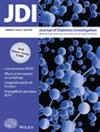Effectiveness of tele-guidance for physiotherapy in older patients with type 2 diabetes: A randomized controlled trial
Abstract
Aims/Introduction
Whether regular intervention via modern communication tools is effective in older patients with type 2 diabetes is unclear. We aimed to determine the effects of tele-guidance for physiotherapy on muscle strength in such patients.
Materials and Methods
This randomized controlled trial was conducted at seven hospitals across Japan. The study participants were 74 older patients with type 2 diabetes randomly assigned to either the tele-guidance for physiotherapy group, which received weekly telephone interventions, or the non-intervention group. Both groups performed a combined aerobic and resistance exercise program. The intervention period was 6 months, during which the tele-guidance for physiotherapy and non-intervention groups received remote physiotherapy instruction once weekly and at the 3-month mark, respectively.
Results
Knee extension force was significantly increased in the tele-guidance for physiotherapy group (from 1.25 ± 0.52 to 1.34 ± 0.54 Nm/kg) but significantly decreased in the non-intervention group (from 1.28 ± 0.46 to 1.22 ± 0.43 Nm/kg). Hemoglobin A1c levels improved significantly in the tele-guidance for physiotherapy and non-intervention groups (from 9.5 ± 2.6 to 7.4 ± 1.6% and from 10.2 ± 2.5 to 7.6 ± 2.0%, respectively). Adherence to the physiotherapy program was significantly higher in the tele-guidance for physiotherapy group than in the non-intervention group (71.8% vs 48.6%).
Conclusions
Weekly tele-guidance for physiotherapy proved effective in improving knee extension force and increasing physiotherapy adherence in older patients with type 2 diabetes. Tele-guidance may be a valuable intervention to improve muscle strength in such patients, offering a cost-effective, accessible solution for healthcare management.


 求助内容:
求助内容: 应助结果提醒方式:
应助结果提醒方式:


